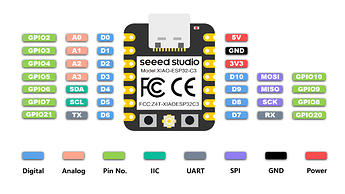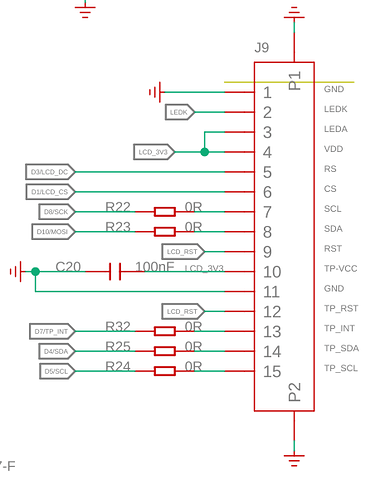Sure thing - hope this helps.
I got most of it working - however there is no support for the TouchScreen used so that doesn’t work.
In this code, I read the CO2, temp etc of sensors in HA and then display from animated .gif files on the display. As I was not able to get the touchscreen working, I used pages and intervals to move to the next page automatically.
The result is really good, but as the board I am using (SeeedStudio XIAO C3) only has 4mb of memory - storing the GIF images was problematic. Hope this helps…
It would be awesome if the touchscreen could be made compatible with ESPHome as this round display is otherwise excellent.
substitutions:
change device name to match your desired name
device_name: “round-display-3”
change the below to be your WiFi SSID
ssid: “xxxx”
change the below to be your WiFi password
wifi_password: “xxxxx”
screenstart: ALWAYS_ON
screenstart: ALWAYS_OFF
Timeout for the screen
screensaver: 1 min
timez: Pacific/Auckland
dcpin: GPIO5 #checked okay
cspin: GPIO3 #checked okay
sckpin: GPIO8
mosipin: GPIO10
#TouchPanel
tp_int: GPIO20
sdapin: GPIO6 #checked
sclpin: GPIO7 #checked
bkpin: GPIO21 #with the KE Swith 2 on the ON position.
esphome:
name: $device_name
platformio_options:
board_build.flash_mode: dio
esp32:
board: esp32-c3-devkitm-1
variant: esp32c3
framework:
type: esp-idf
Enable logging
logger:
level: DEBUG #makes uart stream available in esphome logstream
logs:
component: ERROR
Enable Home Assistant API
api:
encryption:
key: “xxx”
ota:
password: “xxxx”
wifi:
ssid: $ssid
password: $wifi_password
use_address: xxxxx
Enable fallback hotspot (captive portal) in case wifi connection fails
ap:
ssid: “round-display-3”
password: $wifi_password
manual_ip:
# Set this to the IP of the ESP
static_ip: xxxxx
# Set this to the IP address of the router. Often ends with .1
gateway: xxxxxx
# The subnet of the network. 255.255.255.0 works for most home networks.
subnet: 255.255.255.0
captive_portal:
web_server:
port: 80
version: 2
include_internal: true
spi:
clk_pin: $sckpin
mosi_pin: $mosipin
i2c:
sda: $sdapin
scl: $sclpin
scan: true
id: i2c_bus1
time:
- platform: homeassistant
timezone: “$timez”
id: esptime
qr_code:
- id: website_qr
value: “xxxxx”
output:
- platform: ledc
pin: $bkpin
id: backlight_pwm
light:
- platform: monochromatic
output: backlight_pwm
name: “Display Backlight”
id: back_light
restore_mode: ALWAYS_ON
text_sensor:
- platform: homeassistant
id: display_backlight
entity_id: input_number.backlight_level
internal: true
on_value:
then:
- output.turn_on: backlight_pwm
- output.set_level:
id: backlight_pwm
level: !lambda
return atoi(id(display_backlight).state.c_str()) / 100.0;
display:
- platform: ili9xxx
model: GC9A01A
auto_clear_enabled: True
id: watchface
cs_pin: $cspin
dc_pin: $dcpin
dimensions:
height: 240
width: 240
update_interval: 0.1s
pages:
- id: page1
lambda: |-
it.printf(75,15, id(font_35), “Office:”);
it.image(30, 65, id(co2), COLOR_ON, COLOR_OFF);
it.printf(80,75, id(font_20), “CO2: %.0f ppm”, id(office_co2).state);
it.image(30, 110, id(temperature), COLOR_ON, COLOR_OFF);
it.printf(80,120, id(font_20), “Temp: %.0f °C”, id(office_temp).state);
it.image(30, 160, id(heartrate), COLOR_ON, COLOR_OFF);
it.printf(80,170, id(font_20), “BPM: %.0f”, id(heartrate_level).state);
it.strftime(80,215, id(font_12), “%d-%m-%y %H:%M”, id(esptime).now());
- id: page2
lambda: |-
it.printf(75,15, id(font_35), “Office:”);
id(co2).next_frame();
id(temperature).next_frame();
it.image(30, 65, id(co2), COLOR_ON, COLOR_OFF);
it.printf(80,75, id(font_20), “CO2: %.0f ppm”, id(office_co2).state);
it.strftime(80,215, id(font_12), “%d-%m-%y %H:%M”, id(esptime).now());
- id: page3
lambda: |-
it.qr_code(45, 45, id(website_qr), Color(255,255,255), 6);
- id: page4
lambda: |-
it.printf(75,15, id(font_35), “Office:”);
it.image(25, 65, id(wifi_image));
it.printf(75,75, id(font_20), “Wifi dB: %.0f dB”, id(wifi_signal_db).state);
it.image(25, 110, id(wifi_image));
it.printf(75,120, id(font_20), “Wifi Signal %: %.1f%%”, id(wifi_signal_percent).state);
- id: page5
lambda: |-
auto red = Color(255, 0, 0);
it.circle(120,120,119, red);
sensor:
- platform: homeassistant
id: office_co2
name: “Co2 Levels”
entity_id: sensor.office_co2
unit_of_measurement: “ppm”
internal: True
- platform: homeassistant
id: office_temp
name: “Temperature”
unit_of_measurement: “°C”
entity_id: sensor.garage_sensor_temperature
internal: True
- platform: homeassistant
id: heartrate_level
name: “Heartrate”
unit_of_measurement: “bpm”
entity_id: sensor.office_heartrate_level
internal: True
- platform: wifi_signal # Reports the WiFi signal strength/RSSI in dB
name: “WiFi Signal dB”
id: wifi_signal_db
update_interval: 60s
entity_category: “diagnostic”
- platform: copy
Reports the WiFi signal strength in %
source_id: wifi_signal_db
id: wifi_signal_percent
name: “WiFi Signal Percent”
filters:
- lambda: return min(max(2 * (x + 100.0), 0.0), 100.0);
unit_of_measurement: “%”
entity_category: “diagnostic”
device_class: “”
font:
- file: “gfonts://Roboto”
id: font_35
size: 35
- file: “gfonts://Roboto”
id: font_25
size: 25
- file: “gfonts://Roboto”
id: font_10
size: 10
- file: “gfonts://Roboto”
id: font_12
size: 12
- file: “gfonts://Roboto”
id: font_16
size: 16
- file: “gfonts://Roboto”
id: font_24
size: 24
- file: “gfonts://Roboto”
id: font_32
size: 32
- file: “gfonts://Roboto”
id: font_20
size: 20
animation:
- file: “images/co2.gif”
id: co2
type: RGBA
- file: “images/temperature.gif”
id: temperature
type: RGBA
- file: “images/heart_rate.gif”
id: heartrate
type: RGBA
image:
interval:
- interval: 0.1s
then:
animation.next_frame: co2
- interval: 0.1s
then:
animation.next_frame: temperature
- interval: 0.1s
then:
animation.next_frame: heartrate
- interval: 5s
then:
- display.page.show_next: watchface
- component.update: watchface


